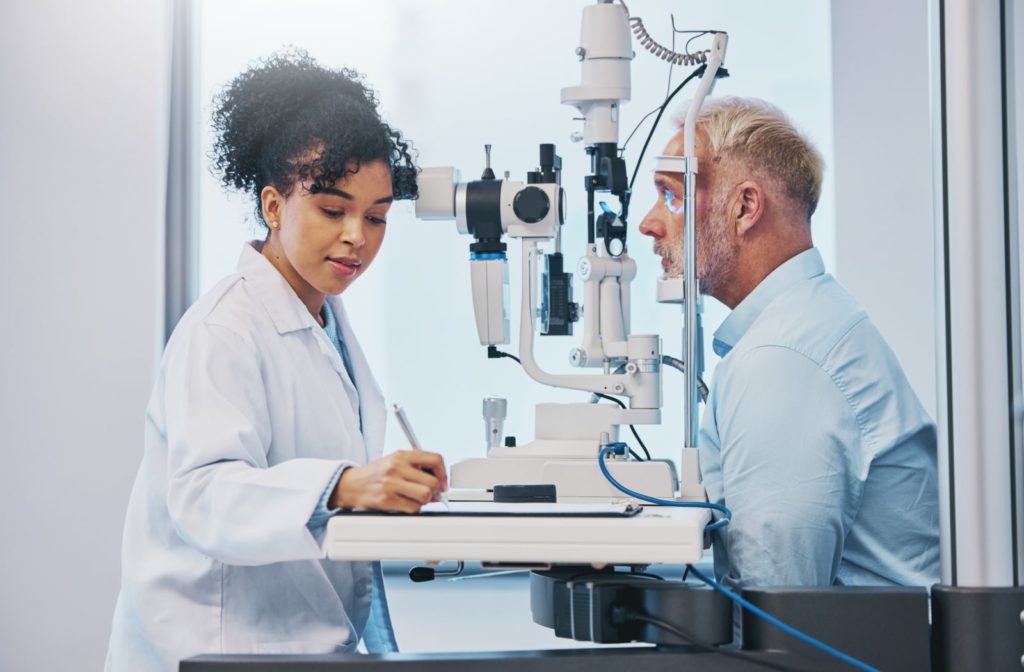Your vision is a gift, and caring for it takes some effort. Having a comprehensive eye exam is crucial to maintaining your eye health and detecting early signs of vision problems.
Even if you think your eyesight is excellent and you have no eye problems, it’s still essential to have regular eye exams because many eye diseases show no symptoms until they have advanced.
Eye exams involve a series of tests to assess your vision and the internal structures of your eye. Tests such as visual acuity, eye movement, and slit lamp exams help your optometrist update your prescription and detect early signs of eye diseases.
What Happens in a Comprehensive Eye Exam?
After taking your updated medical history, your optometrist will conduct a series of exams.
Visual Acuity Test
The visual acuity test is usually the first test performed in an eye exam. During this test, you will read a series of letters from a distance, and your optometrist will evaluate your ability to see clearly. This test helps determine your level of myopia, hyperopia, astigmatism, or presbyopia.
Refraction Test
If you need glasses or contact lenses, your optometrist will perform a refraction test. The refraction test determines the precise prescription needed for eyeglasses or contact lenses to correct your vision. Your optometrist will use a phoropter device, which contains numerous lenses of different strengths. You will look through the phoropter, and your optometrist will switch the lenses and ask which produces the clearest vision.
Visual Field Test
The visual field test examines your peripheral vision (side vision). There are various types of visual field tests your optometrist may use. This test is critical for everyone to monitor the entire field of vision. However, it’s particularly vital for those with:
- Glaucoma
- Multiple sclerosis
- Graves’ disease
- Pituitary gland disorders
- A history of strokes
- Long-term use of specific medication
- Those with diabetes
Eye Movement Test
The eye movement test checks how well your eyes can move in different directions. It also assesses how well your eyes can work together. This test focuses on the eye muscles to determine how they perform visual tasks.
Slit-Lamp Test
The slit-lamp test allows your optometrist to observe your eye’s internal structures. This test uses a microscope with a bright light to examine parts of the eye for signs of disease or injury, including the:
- Cornea
- Conjunctiva
- Iris
- Lens
- Sclera
- Retina
- Optic nerve
A slit-lamp test is critical in diagnosing conditions like macular degeneration, retinal detachment, cataracts, or blockages in the eye’s blood vessels.
Tonometry
The tonometry test measures the pressure inside your eye, called intraocular pressure (IOP). The measurement can determine whether you’re at risk of or are developing glaucoma. Factors that place people at higher risk of developing glaucoma include:
- Family history
- Have other chronic eye conditions
- High myopia
- Diabetes
- High blood pressure
- Poor blood circulation
How Often Should You Have an Eye Exam?
Adults
The general recommendation is that adults should have a comprehensive eye exam at least once every 2 years. However, if you wear glasses or contact lenses or if you have a family history of eye diseases such as glaucoma or macular degeneration, an annual eye exam may be needed to update your prescription and support overall eye health.
Children
For children, it’s especially important to have regular eye exams.
- Infants should have their first eye examination between 6 and 9 months
- Children should have their next eye exam between 2 and 5 before entering kindergarten
- As they enter school age, they should have annual eye exams
Vision problems can significantly impact a child’s development and educational performance, so early detection and treatment are essential.
Diabetic Eye Exams
If you have diabetes, having an annual eye exam is crucial. High blood sugar levels can damage the blood vessels in your eyes, leading to diabetic retinopathy and, eventually, vision loss if left untreated.
Keeping blood sugar, blood pressure, and cholesterol regulated can help support healthy vision and eyes.
Schedule Your Comprehensive Eye Exam
If you are experiencing any changes in your vision, such as blurred vision, frequent headaches, or difficulty seeing at night, you should schedule an eye exam promptly. These symptoms may indicate the need for a new glasses prescription or could be a sign of a more severe issue requiring immediate attention.
Regular comprehensive eye exams are vital in maintaining healthy vision. Schedule an appointment at Doctors EyeCare Grande Prairie for your comprehensive eye exam today.




